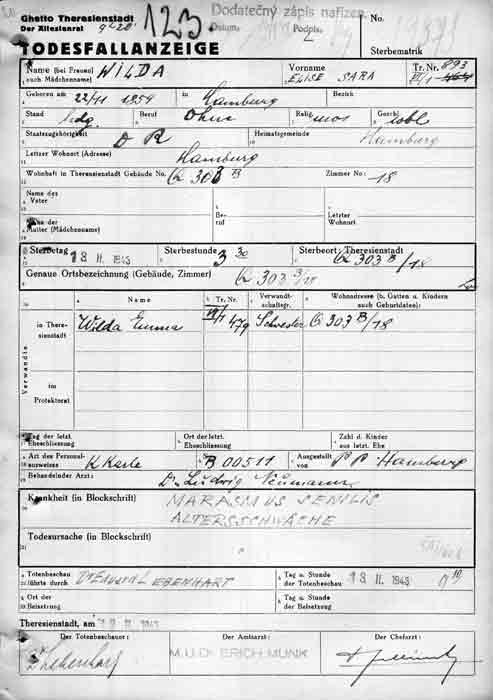Search for Names, Places and Biographies
Already layed Stumbling Stones
Suche
Elise Wilda * 1859
Lenhartzstraße 3 (Hamburg-Nord, Eppendorf)
1942 Theresienstadt
ermordet 13.2.1943
further stumbling stones in Lenhartzstraße 3:
Ina Behrmann, Siegmund Hofmann, Hermine Hofmann, Wolf Jägermann, Carl Löwenberg, Selma Meyer, Elka Naphtalie, Gerda Pulka, Marie Sievers, Emma Wilda, Therese Wilda, Ernst Wilda
Elise Wilda, born on 22 Nov. 1859, deported to Theresienstadt on 15 July 1942, died there on 13 Feb. 1943
Emma Wilda, born on 16 Apr. 1872, deported to Theresienstadt on 15 July 1942, died there on 21 Mar. 1943
Ernst Wilda, born on 30 Apr. 1863, deported to Theresienstadt on 15 July 1942, died there on 6 Aug. 1942
Therese Wilda, born on 20 Nov. 1870, deported to Theresienstadt on 15 July 1942, died there on 27 Jan. 1943
Lenhartzstrasse 3
The Wilda siblings lived together on Meridianstrasse in Hamburg-Hamm for many years before moving together to Lenhartzstrasse 3.
The four siblings sharing an apartment was nothing unusual. All of them were single, had an education, and made a living as long as they were not affected by economic crises or illness. There were two other siblings, Prof. Hermann Wilda, born on 4 Feb. 1862, who taught shipbuilding at the Bremen State Technical College (Staatliches Technikum), and Paul, who emigrated to Brazil around 1933. Their parents were the painter Wilhelm Wilda, born in 1816 in Hamburg, and Leonore Sophie Oppert, also born in Hamburg. They had married on 13 Dec.1857. Wilhelm Wilda died in 1881 at the age of 65 when his eldest daughter, Elise, was 22 years old and his youngest, Emma, was aged nine.
In Apr. 1905, Ernst Wilda as head of the household, Paul, the three sisters, and their mother moved into a new apartment at Meridianstrasse 13 in Hamburg-Hamm, where Leonore Sophie Wilda died two years later at the age of almost 78.
When Ernst Wilda was registered in the Jewish Community in 1913, he worked as an independent sales representative, lived in Hamm, and ran his export agency at Grosser Burstah 16. After the First World War, for which he was too old to be drafted, he went to Berlin, but returned as early as 1920 and reopened an export agency, but was unable to regain a foothold professionally.
In 1915/16, ten-year-old Maria Wilda from Bremen lived with her relatives for six months.
Paul Wilda had become a bank official and married the teacher Felice Wulff in 1910. The couple lived in Winterhude, where their sons Heinz and Gerhard were born.
It is not known what kind of work Emma did. Elise and Therese Wilda were elementary school teachers (Volksschullehrerinnen) at municipal schools, with permanent positions and pension entitlements. They received their training in teacher training colleges outside Hamburg: Elise in Hannover, Therese in Münster. According to the 1920 teachers’ register, they served in School District 4, Billwärder Ausschlag, today’s Rothenburgsort. Elise Wilda taught at the girls’ school at Vierländerstrasse 79, Therese at the boys’ school at Bullenhuserdamm 94. Elise also got involved in professional associations; she belonged to the "Association of Hamburg Female Elementary School Teachers” ("Verein Hamburger Volksschullehrerinnen”). She retired on 1 Jan. 1925. Her pension was cut in the early 1930s due to emergency decrees.
In 1932, Therese went into early retirement because of an eye disease. This made the financial situation of the siblings even more difficult. In 1931, Elise Wilda approached the Hamburg German-Israelitic Community with a request for tax remission. Her request was rejected on the grounds that "the need in which our community finds itself is so great that we are dependent on every sum assessed.” At least, the Community accommodated her by means of a tax reduction and deferral.
On 30 Apr. 1939, the "Law on Tenancies with Jews” ("Gesetz über die Mietverhältnisse mit Juden”) abolished the protection against unwarranted eviction for Jewish tenants. At that point, often with the help of the Community, they had to find an apartment as tenants or subtenants in "Jews’ houses” ("Judenhäuser”) or were assigned one.
In 1940/41 Ernst, Elise, Emma, and Therese Wilda moved from Meridianstrasse 13 to Lenhartzstrasse 3, a house owned by the Jewish merchant Leon Guttmann (see "Das ‘jüdische Haus’ Lenhartzstrasse 3”). For many who lived here, Lenhartzstrasse was only a stop on the way to a "Jews’ house.” The Wilda siblings were also accommodated by the Jewish Community at Frickestrasse 24, where their sister-in-law already lived. Felice Wilda succeeded in emigrating to Brazil to join her son. She left for Rio de Janeiro on 30 Jan. 1941. Her moving goods never arrived and they were auctioned off under the name of her brother-in-law Ernst.
It is not known why the four brothers and sisters were taken into "protective custody” ("Schutzhaft”) in the Fuhlsbüttel concentration camp for one day each in Feb. 1942; perhaps they violated the obligation to wear the "Jews’ star” ("Judenstern”).
On 15 July 1942, they were transported together to the Theresienstadt Ghetto. Ernst Wilda was the first one of them to die there, Emma the last one. Therese died officially on 27 Jan. 1943 at 6.30 a.m. of a bladder disease, Elise died on 18 Nov. 1943 at 3.30 a.m. of "old age.”
Translator: Erwin Fink
Kindly supported by the Hermann Reemtsma Stiftung, Hamburg.
Stand: May 2019
© Maria Koser
Quellen: 1; 2; 3; 4; 5; 7; 9; StaH 522-1 Jüd. Gemeinden, o.Sign., Mitgliederzählung der DIGH 1928, 390 Wählerverzeichnis 1930, 391 Mitgliederliste 1935, 992 d Steuerakten Band 34, 992e2 Band 4; StaH 332-5 Standesämter, 1038 und 377/1935 (Paul Wilda); StaH 314-15 OFP, Fvg 8381; StaH 214-1 Gerichtsvollzieherwesen, 709; StaH 332-5 Standesämter, 94 und 842/1881 (Wilhelm Wilda) und 591 und 95/1907 (Sophie Wilda); StaH 332-8 Meldewesen, K 7173; Thevs, Hildegard, Stolpersteine in Hamburg-Hamm S. 102–104; Hamburger Lehrerverzeichnis, Jg. 1920/21, Jg. 1927, Jg. 1930, Jg.1933; Degener (Hrsg.), Wer ist’s?, 1909, S. 1550.
Zur Nummerierung häufig genutzter Quellen siehe Link "Recherche und Quellen".


